Harvesting medicinal herbs for personal use
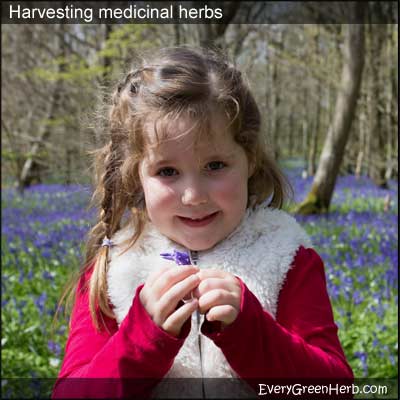
Know what you are harvesting!
Correct plant identification is very important when harvesting wild herbs. To harvest wild plants, you have to know what is what. Never trust a photo when gathering wild herbs.
For example, cleavers look like a type of wild mustard that can cause irritation. A person thinking they are using cleavers in home-made deodorant will quickly realize something is wrong when their armpits start burning.
Other mistakes are more dangerous and can be life threatening.
The best way to identify any herb, mushroom, or wild plant is with the help of an experienced guide. Whether relative, neighbor, or friend, make sure they are qualified!
A good field guide is the next best thing, but never depend on a photo or illustration (unless it is clear that the plant is easy to ID with no look-a-likes that are poisonous).
Medicinal herbs can be identified by color, leaf shape, stem shape, growth pattern, smell, and habitat.
Once again, never harvest anything that you cannot identify. Poisonous plants can cause rash, stomach upset, and even death.

Harvest medicinal herbs in spring, summer, fall, and winter
Harvest herbs in spring, summer, fall, and winter. Many wild herbs are free for the picking.
- Harvest dandelion greens from your lawn in spring.
- Pick bee balm and most flowering herbs in summer.
- Dig ginseng in the fall and look for rose hips in the winter. The list goes on and on.
Mullein, mountain mint, bee balm, blackberry leaf, yarrow, plantain, chickweed, cleavers, red clover, and nettle (just to name a few) grow in fields, meadows, and most yards. Always ask permission before harvesting plants on someone else's property.
Do not harvest plants that have been grown in contaminated areas, sprayed with chemicals, or exposed to car fumes.
Harvesting wild herbs comes with risks.
There are other things besides toxins to avoid when gathering wild herbs. Biting and stinging insects come to mind.
Here in the south, we have chiggers (mites that burrow under the skin). To repel chiggers and ticks rub socks, shoes, and pants legs with lavender essential oil. Dusting shoes with sulfur before stomping through weeds is also effective.
Once a chigger bites, there's not a whole lot you can do, although itching can be treated with peppermint, chickweed, and hot compresses.
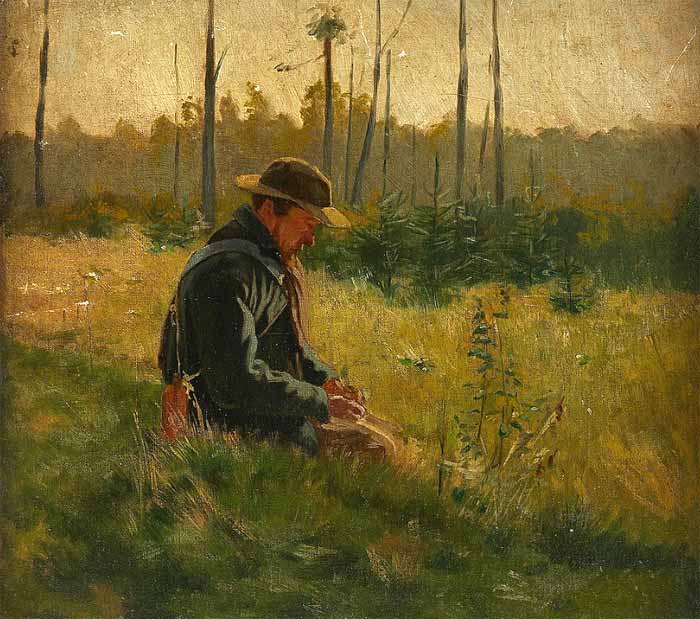
Watch out for poison oak, ivy, and shoemake (poison sumac), too. If you realize that you are in a patch of poison oak or ivy, look around for some jewelweed (with small orange flowers), and rub the juicy leaves on exposed area immediately. If you can't find jewelweed, wash with soap and water as soon as possible. It is best to wash within 10 minutes!
Jewelweed is often found growing near poisonous plants and may help stop harmful reactions. If you are near water, wash well for at least five minutes even if you don't have soap. Getting the poison off of your skin before damage can take place is the best remedy.
Carry gloves and watch out for snakes when harvesting wild herbs.
Gloves are required when gathering stinging nettle. Nettle has tiny hair that irritate the skin. Once cooked, nettles lose their sting and are a nutritious food.
In the southern Appalachians, watch out for copperheads and rattlers, although they usually slip away undetected and cause no harm.
Wear sunscreen and if you are allergic to bees, have a bee-sting kit on hand.
Harvest mullein, mint, and bee balm in July.
Mullein leaves are at their peak in July and still have a few flowers left if there haven't been a lot of strong winds.
Mountain mint makes excellent iced tea so gather some of that, too.
In July, bee balm leaves are at just the right stage for powerful bedtime teas. You will want to harvest enough to use fresh, and to dry for winter use.
Get into the habit of drinking herbal teas and your body, mind, and spirit will greatly benefit.
Harvest just before herbs start to flower.
Many people grow culinary herbs in their backyards. Rosemary, thyme, lavender, chives, cilantro, sage, basil, fennel, garlic, dill, peppermint, spearmint, and parsley are southern favorites.
Most culinary herbs are at their peak of flavor just before or during flowering, so harvest may begin in June or July.
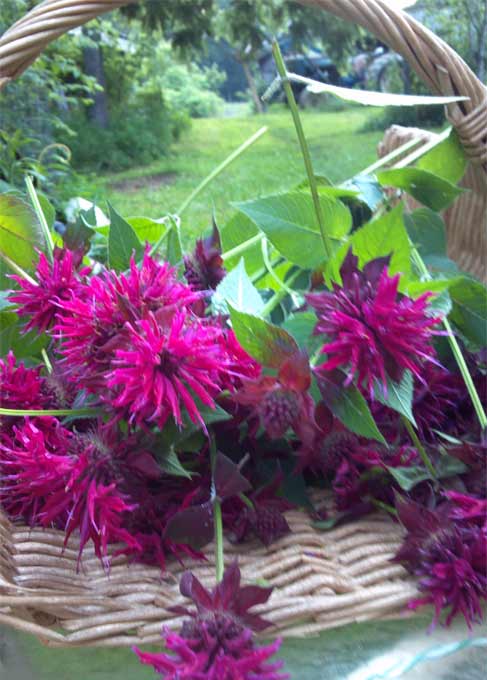
Harvest herbs on a dry day.
Do not harvest leafy herbs right after a shower or when the dew is on the leaves. Harvest on a dry day.
After cutting, shake off all bugs and debris. Do not gather dusty herbs or you will have to wash them before drying, which can cause mold or rot.
Do not gather any herbs that show signs of mildew or disease.
Store extra herbs for later use.
Fresh herbs must be prepared for storage if not used within a few days. There are many ways to preserve leafy herbs.
Dehydration, infused oils, tinctures, ointments, and even the freezer can capture healing properties for winter use. Read more about making your own herbal products.
Leafy green herbs like basil and tarragon can be chopped and frozen with olive oil or water in ice cube trays. Once frozen solid, put individual cubes in a freezer bag and add as needed to beverages, stews, gravies, soups, and broths.
Preserve herbs by drying
The traditional way to prepare herbs for storage is dehydration or drying.
Hang upside down in a well ventilated, dark place with a temperature around 75 degrees. Make sure that the air circulates. even if you have to use a fan. Do not crowd the green plants when drying. Mold is easily prevented if air flow is good.
If your herbs mold, they are only fit for the compost pile! Do not use moldy herbs.
I like to use a dehydrator when humidity is high. I have a small one that is just right for gently drying my herbs. Always dry herbs on the lowest setting since high heat can destroy healing properties.
When herbs are dry, store in airtight containers.
Herbs should be ready in a week or two when hung in a dry, dark place. Strip off leaves from stems when brittle, and store in a clean glass container with an airtight lid.
Herbs can also be stored in paper or cloth bags. Watch for bugs, mold, and mildew. Discard all herbs that are suspect.
Label containers with variety and date. Keep the containers in a dark, cool place for best results.
Most dried herbs will keep between twelve and eighteen months before losing their culinary flavors and medicinal properties.
Large leaves like mullein can be harvested and dried individually. Smaller leaves like thyme are best left on the stem.
Gather leaves of deciduous herbs just before flowering and evergreen herbs like rosemary throughout the year.

Dry herbal flower tops on wooden or woven bamboo trays.
When harvesting flower tops like chamomile or calendula, gather after dew has evaporated. Cut heads from stems and dry on trays. Larger flowers may need to be pulled apart for even and complete drying.
Always remove dirt and insects before drying.
Harvesting seeds from plants
When harvesting seeds, pick the entire plant when its seeds are almost ripe. Hang upside down inside a paper bag, out of direct sunlight.
If harvesting larger plants for the seeds, cut off seed pods before the birds get them. Keep in a paper bag until the seeds are dry, then separate from their stalks and stems.
Seeds should fall off when ripe, usually within two weeks.
You may have to separate the stems from the seeds by hand, if they don't come apart on their own. This can be accomplished with various size strainers, screens, and colanders.
You can also put your seeds in a bowl and blow on them (do this outdoors so all the unwanted plant material can float away in the breeze). Heavy seeds will stay in the bowl and the lighter parts will blow away. This process is a lot like separating chaff from grain and is known as winnowing.
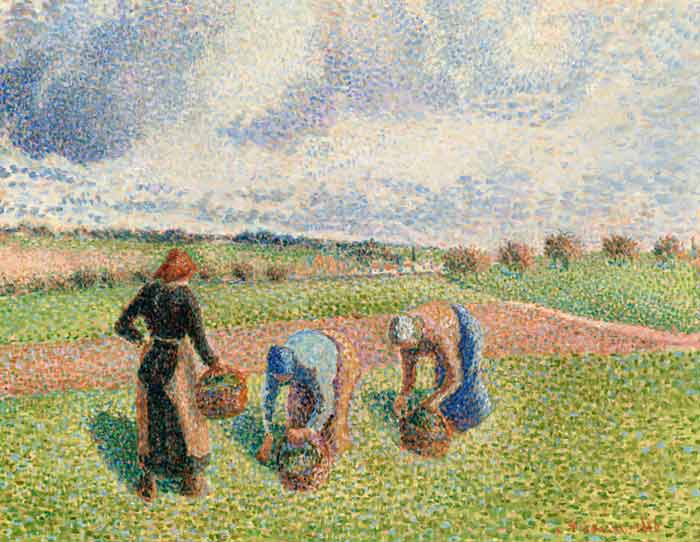
Harvest herbal roots, wash, and chop before drying.
When harvesting medicinal roots, wash and chop while fresh. Gather most roots in autumn, except for dandelion which is harvested in spring.
Spread roots on cookie sheet and dry for 3 or 4 hours in a warm oven. Transfer to a warm, sunny room to complete the drying process.
Sometimes dried roots will absorb moisture from the air. They will become soft or moldy and must be discarded. I keep my dried roots in tightly sealed jars or the freezer so they will last longer.
Harvest tree sap in the autumn.
Harvest tree sap and resin in the autumn when sap is falling by making a deep incision in the bark. Catch the sap in a cup. It's like collecting maple sap for syrup making!
Harvest juice from plants like Aloe Vera any time. Squeeze sap into a bowl or cut the leaf and scrap with a knife.
Harvest medicinal fruit when ripe but not mushy.
Harvest fruit like rose hips when almost ripe but not mushy. Spread on trays to dry or use a dehydrator.
Turn fleshy fruits frequently. Discard any fruit that shows signs of rot or mold.
Harvest bark in autumn.
Harvest bark like white willow and wild cherry bark in autumn. This minimizes damage to tree.
Don’t remove a complete band unless you plan to kill the tree! Dust off bark to remove dirt, moss, and insects. Break into pieces and dry.
Harvest bulbs in late summer or early fall.
Bulbs like garlic should be harvested when aerial parts have wilted or dried out. Leave the paper like covering on the bulbs for protection, and hang them in an airy location to dry. Use as needed.
Garlic can also be sliced or chopped and dried in a dehydrator. Homegrown, dried garlic makes excellent garlic powder if you have a way to grind it.
I use a coffee bean grinder. Homemade garlic powder is a lot fresher and stronger than what can be found in a store. Since it is not old, it also contains many medicinal properties that are lost as herbs age.
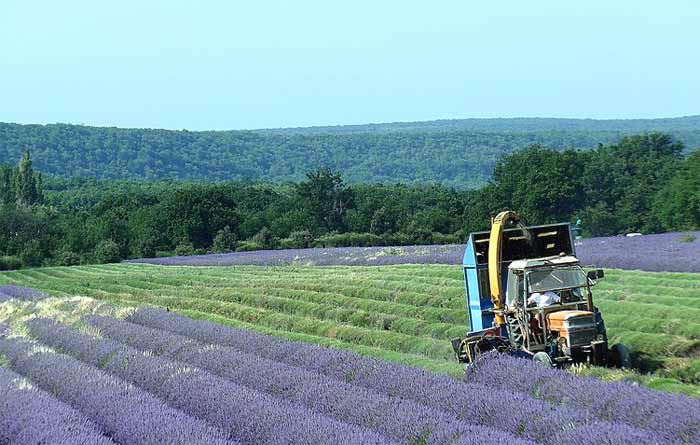
Time of harvest matters
Studies on the Chinese herb, Chuan Bei, (Fritillaria cirrhosa) show that different harvest times have a big impact on yield and quality.
Beneficial alkaloids reached the highest point at mid and late flowering (withering) stages of plant growth. Oven drying was slightly better than sun drying.
As an experienced herbalist, I am glad to see well-known facts supported by science.
Medicinal herbs are living medicines.
All herbs are gifts from God and should be treated with respect.
Herbal medicine is an art that everyone can learn. When a person handles and works with a certain herb, a relationship is formed.
After growing and harvesting herbs, you will become more and more comfortable and knowledgeable. Herbal medicine will become a way of life if you let it.
Please remember that most herbal remedies are not quick fixes.
Herbal medicines take time to work. Many people give up after a couple of days. When there's a choice of herbs to use, let your body be your guide. If one herb smells unpleasant to you and another smells good, then choose the one that pleases you.
If you have a known allergy to any plant, be careful using any of its relatives. Listen to what your body tells you.
Grow herbs in the right locations and they will thrive.
Culinary herbs usually need well drained soil, plenty of sunlight, and protection from wind. Rosemary, thyme, and many culinary herbs originate in warm, dryer climates so that makes sense.
Medicinal herbs usually like partial shade. Most medicinal herbs are native to woodland settings. They grow best in moist, rich soil.
Tall herbs like angelica, comfrey, fennel, mullein, and foxglove should be placed in the back of a border.
Calendula, sage, and cilantro work in the middle while thyme and oregano should be out front.
* Never gather herbs that are on an endangered plant list. Always leave some specimens to reproduce and just take what you will actually use. Digging ginseng usually requires a permit.
Always consult with a healthcare professional before using any herbal remedy especially if pregnant, nursing, or taking other medicines.
Sources:
https://www.ncbi.nlm.nih.gov/pmc/articles/PMC8194732/
Blessings to you and yours!
Thanks so much for reading my blog. Jan.

*Note - the information on this website has not been evaluated by the Food and Drug Administration.
© 2005-2024 website design and content by Janice Boling